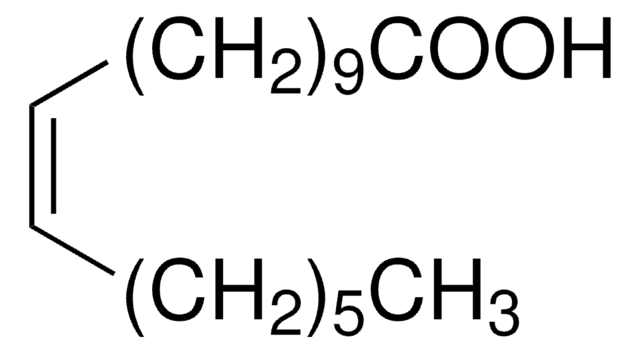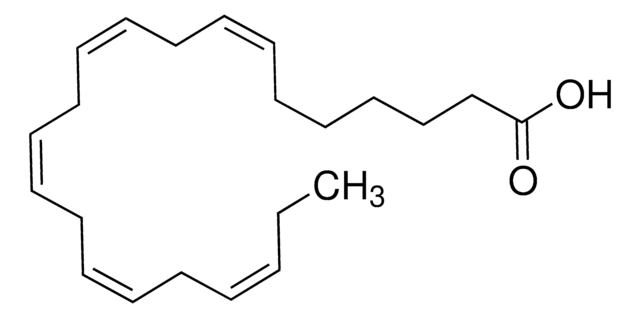69301
cis-Vaccenic acid
analytical standard
Sinónimos:
octadec-11(cis)-enoic acid, cis-11-Octadecenoic acid
About This Item
Productos recomendados
grade
analytical standard
assay
≥97.0% (HPLC)
form
liquid
shelf life
limited shelf life, expiry date on the label
impurities
≤0.5% trans-isomer
refractive index
n20/D 1.459 (lit.)
bp
150 °C/0.03 mmHg (lit.)
mp
14-15 °C (lit.)
density
0.887 g/mL at 25 °C (lit.)
application(s)
clinical testing
storage temp.
−20°C
SMILES string
CCCCCC\C=C/CCCCCCCCCC(O)=O
InChI
1S/C18H34O2/c1-2-3-4-5-6-7-8-9-10-11-12-13-14-15-16-17-18(19)20/h7-8H,2-6,9-17H2,1H3,(H,19,20)/b8-7-
InChI key
UWHZIFQPPBDJPM-FPLPWBNLSA-N
¿Está buscando productos similares? Visita Guía de comparación de productos
General description
Application
- Quantification of the analyte and its photodegradation products in marine samples using gas chromatography coupled to electron impact mass spectrometry (GC-EIMS). The photo-oxidation of the lipid components of the two strains of aerobic photoheterotrophic bacteria, Erythrobacter sp. strain NAP1 and Roseobacter-related isolate COL2P is studied and the results obtained after irradiation of axenic and nonaxenic cultures of the diatom, Skeletonema costatum is compared.
- Quantification of the analyte in the methanolic extract of the leaves of Lepidium sativum using gas chromatography coupled to mass spectrometry (GC-MS).
- Quantification of the analyte in methanolic extract of Rosmarinus oficinalis leaves using gas chromatography coupled to mass spectrometry and Fourier transform infrared spectroscopy.
Recommended products
Storage Class
10 - Combustible liquids
wgk_germany
WGK 3
flash_point_f
446.0 °F - closed cup
flash_point_c
230 °C - closed cup
Elija entre una de las versiones más recientes:
¿Ya tiene este producto?
Encuentre la documentación para los productos que ha comprado recientemente en la Biblioteca de documentos.
Nuestro equipo de científicos tiene experiencia en todas las áreas de investigación: Ciencias de la vida, Ciencia de los materiales, Síntesis química, Cromatografía, Analítica y muchas otras.
Póngase en contacto con el Servicio técnico







